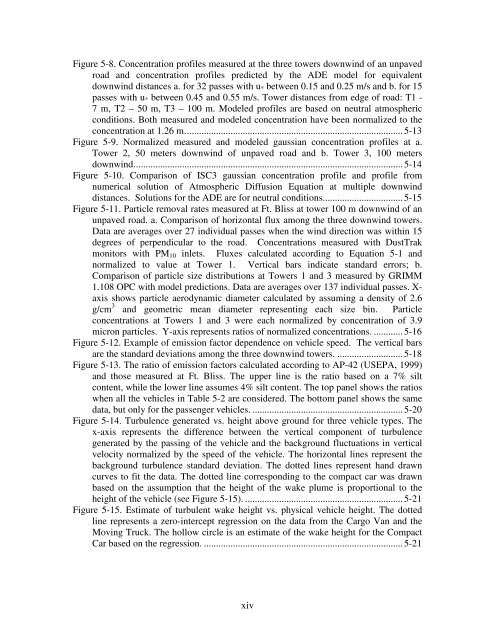FIELD TESTING AND EVALUATION OF DUST DEPOSITION AND ...
FIELD TESTING AND EVALUATION OF DUST DEPOSITION AND ...
FIELD TESTING AND EVALUATION OF DUST DEPOSITION AND ...
Create successful ePaper yourself
Turn your PDF publications into a flip-book with our unique Google optimized e-Paper software.
Figure 5-8. Concentration profiles measured at the three towers downwind of an unpaved<br />
road and concentration profiles predicted by the ADE model for equivalent<br />
downwind distances a. for 32 passes with u * between 0.15 and 0.25 m/s and b. for 15<br />
passes with u * between 0.45 and 0.55 m/s. Tower distances from edge of road: T1 -<br />
7 m, T2 – 50 m, T3 – 100 m. Modeled profiles are based on neutral atmospheric<br />
conditions. Both measured and modeled concentration have been normalized to the<br />
concentration at 1.26 m.......................................................................................... 5-13<br />
Figure 5-9. Normalized measured and modeled gaussian concentration profiles at a.<br />
Tower 2, 50 meters downwind of unpaved road and b. Tower 3, 100 meters<br />
downwind............................................................................................................... 5-14<br />
Figure 5-10. Comparison of ISC3 gaussian concentration profile and profile from<br />
numerical solution of Atmospheric Diffusion Equation at multiple downwind<br />
distances. Solutions for the ADE are for neutral conditions................................. 5-15<br />
Figure 5-11. Particle removal rates measured at Ft. Bliss at tower 100 m downwind of an<br />
unpaved road. a. Comparison of horizontal flux among the three downwind towers.<br />
Data are averages over 27 individual passes when the wind direction was within 15<br />
degrees of perpendicular to the road. Concentrations measured with DustTrak<br />
monitors with PM 10 inlets. Fluxes calculated according to Equation 5-1 and<br />
normalized to value at Tower 1. Vertical bars indicate standard errors; b.<br />
Comparison of particle size distributions at Towers 1 and 3 measured by GRIMM<br />
1.108 OPC with model predictions. Data are averages over 137 individual passes. X-<br />
axis shows particle aerodynamic diameter calculated by assuming a density of 2.6<br />
g/cm 3 and geometric mean diameter representing each size bin. Particle<br />
concentrations at Towers 1 and 3 were each normalized by concentration of 3.9<br />
micron particles. Y-axis represents ratios of normalized concentrations. ............ 5-16<br />
Figure 5-12. Example of emission factor dependence on vehicle speed. The vertical bars<br />
are the standard deviations among the three downwind towers. ........................... 5-18<br />
Figure 5-13. The ratio of emission factors calculated according to AP-42 (USEPA, 1999)<br />
and those measured at Ft. Bliss. The upper line is the ratio based on a 7% silt<br />
content, while the lower line assumes 4% silt content. The top panel shows the ratios<br />
when all the vehicles in Table 5-2 are considered. The bottom panel shows the same<br />
data, but only for the passenger vehicles. .............................................................. 5-20<br />
Figure 5-14. Turbulence generated vs. height above ground for three vehicle types. The<br />
x-axis represents the difference between the vertical component of turbulence<br />
generated by the passing of the vehicle and the background fluctuations in vertical<br />
velocity normalized by the speed of the vehicle. The horizontal lines represent the<br />
background turbulence standard deviation. The dotted lines represent hand drawn<br />
curves to fit the data. The dotted line corresponding to the compact car was drawn<br />
based on the assumption that the height of the wake plume is proportional to the<br />
height of the vehicle (see Figure 5-15). ................................................................. 5-21<br />
Figure 5-15. Estimate of turbulent wake height vs. physical vehicle height. The dotted<br />
line represents a zero-intercept regression on the data from the Cargo Van and the<br />
Moving Truck. The hollow circle is an estimate of the wake height for the Compact<br />
Car based on the regression. .................................................................................. 5-21<br />
xiv
















